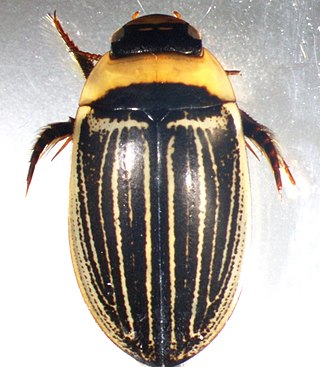Amphizoa lecontei is a species of aquatic beetle. Adults have a body length of between 11.5 and 16 millimeters. Its elytron has a distinct carina on fifth interval. The species is found in western North America, especially in the Rocky Mountains. Its common name is "Trout-stream beetle". Its synonym is Amphizoa carinata.

Amphizoa insolens is a species of aquatic beetles. It is found in North America from Alaska to southern California.
Ilybius incarinatus is a species of predaceous diving beetle in the family Dytiscidae. It is found in North America.

Hydaticus aruspex is a species of predaceous diving beetle in the family Dytiscidae. It is found in North America and the Palearctic.
Hydrovatus brevipes is a species of predaceous diving beetle in the family Dytiscidae. It is found in North America.
Neoporus sulcipennis is a species of predaceous diving beetle in the family Dytiscidae. It is found in North America.
Brachyvatus apicatus is a species of predaceous diving beetle in the family Dytiscidae. It is found in North America and the Neotropics.
Cicindela nebraskana, known generally as the prairie long-lipped tiger beetle or black-bellied tiger beetle, is a species of flashy tiger beetle in the family Cicindelidae. It is found in North America. It grows between 12 and 13 mm in length, and is black in colour.

Cybistrini is a tribe of predaceous diving beetles in the family Dytiscidae. There are 7 genera and 128 described extant species in Cybistrini. The same set is also called Cybistrinae by authors viewing it as a subfamily of Dytiscidae.
Agabus bicolor is a species of predaceous diving beetle in the family Dytiscidae. It is found in North America.
Ilybius hypomelas is a species of predaceous diving beetle in the family Dytiscidae. It is found in North America.
Agabus griseipennis is a species of predaceous diving beetle in the family Dytiscidae. It is found in North America.
Agabus arcticus is a species of predaceous diving beetle in the family Dytiscidae. It is found in North America and the Palearctic.
Hydroporus striola is a species of predaceous diving beetle in the family Dytiscidae. It is found in North America and the Palearctic.
Laccophilus horni is a species of predaceous diving beetle in the family Dytiscidae. It is found in North America and the Neotropics.
Agabus leptapsis is a species of predaceous diving beetle in the family Dytiscidae. It is found in North America.
Neoporus undulatus is a species of predaceous diving beetle in the family Dytiscidae. It is found in North America.
Neoscutopterus angustus is a species of predaceous diving beetle in the family Dytiscidae. It is found in North America.
Ilybius quadrimaculatus is a species of predaceous diving beetle in the family Dytiscidae. It is found in North America.
Rhadine ozarkensis is a species of ground beetle in the family Carabidae. It is found in North America.


